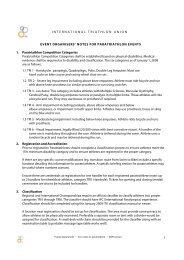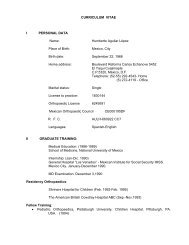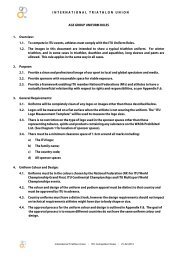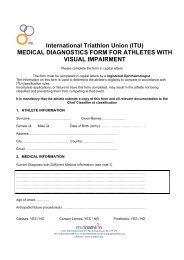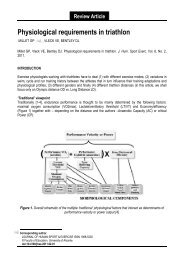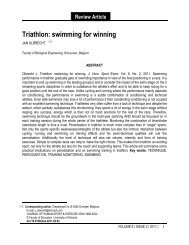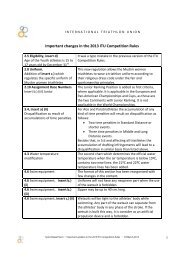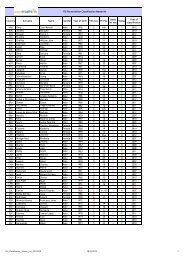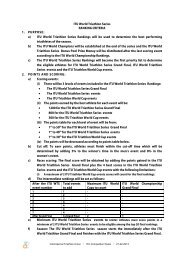ITU Paratriathlon Classification Rules and Regulations 2012 Edition ...
ITU Paratriathlon Classification Rules and Regulations 2012 Edition ...
ITU Paratriathlon Classification Rules and Regulations 2012 Edition ...
Create successful ePaper yourself
Turn your PDF publications into a flip-book with our unique Google optimized e-Paper software.
Signature of Ophthalmologist: ......................................................................................<br />
Date: …………………..<br />
DEFINITION OF ELIGIBILITY<br />
To be eligible to compete in IPC Paralympic Sport, the athlete with visual impairment must be affected by at least one of the<br />
following impairments, resulting from disease/disorder:<br />
- impairment of the eye structure;<br />
- impairment of the optical nerve/optic pathways;<br />
- Impairment of the visual cortex of the central brain.<br />
An athlete evaluation <strong>and</strong> sport class allocation will be based on the assessment of visual acuity in the eye with better visual<br />
acuity whilst wearing best optical correction using spectacles or contact lenses.<br />
IBSA Sport Class B1<br />
An Athlete shall compete in Sport Class B1 if the Athlete is unable to recognize the orientation of a 100M Single Tumbling E<br />
target (height: 145mm) at a distance of 250mm.<br />
Within this class, the vision ability may range from no light perception to a Single Tumbling E visual acuity poorer than<br />
LogMAR = 2.60.<br />
IBSA Sport ClassB2<br />
An Athlete shall compete in Sport Class B2 if the Athlete:<br />
- Is unable to recognize the orientation of a 40M Single Tumbling E target (height: 58mm) at a distance of 1m (STE<br />
LogMAR = 1.60); <strong>and</strong>/or<br />
- Has a visual field that is constricted to a diameter of less than 10 degrees.<br />
Within this class, the vision acuity may range from Single Tumbling E visual acuity poorer than LogMar = 1.60 to Single<br />
Tumbling E visual acuity of LogMar = 2.60.<br />
IBSA Sport Class B3<br />
An athlete will be eligibile for International Triathlon Union if he/she:<br />
- Has a visual acuity that is poorer than LogMar = 1.00 (6/60) measured with an ETDRS letter chart or an equivalent<br />
chart (Tumbling E) in the LogMAR format presented at a distance of at least 1meter.; <strong>and</strong>/or<br />
- Has a visual field that is constricted to a diameter of less than 40 degrees.<br />
Within this class, the visual acuity may range from a letter chart acuity poorer than LogMAR = 1.60 to a Single Tumbling E<br />
visual acuity of LogMAR = 1.60.<br />
Note 1 Diagnosis<br />
Evidence confirming the diagnosis must be attached <strong>and</strong> forwarded with this application. The medical evidence should include a<br />
comprehensive medical history <strong>and</strong> the results of all relevant examinations, laboratory investigations <strong>and</strong> imaging studies. Copies<br />
of the original reports or letters should be included when possible. Evidence should be as objective as possible in the clinical<br />
circumstances <strong>and</strong> in the case of non-demonstrable conditions independent supporting medical opinion will assist this<br />
application. This includes report <strong>and</strong> graphic results (where applicable) on:<br />
- Pattern Visual Evoked Potentials<br />
- Electroretinography / Electrooculography<br />
- Cerebral Magnetic Resonance Imaging<br />
Note 2<br />
Visual Field has to be tested by full-field strategy (30° central field test will not be accepted, by means of any of the following<br />
devices:<br />
- Humphrey Field Analyzer, Twinfield (Oculus), Octopus (interzeag), Rodenstock Peristat, Medmont (MAP),<br />
Goldmann Perimetry Intensity III/4<br />
It is m<strong>and</strong>atory the Athlete submits a copy of this Medical Diagnostic Form <strong>and</strong> all relevant<br />
documentation to the <strong>ITU</strong> Chief Classifier when he/she presents for classification<br />
40




